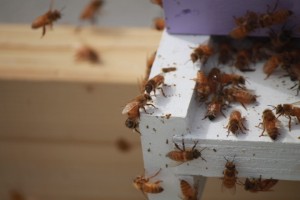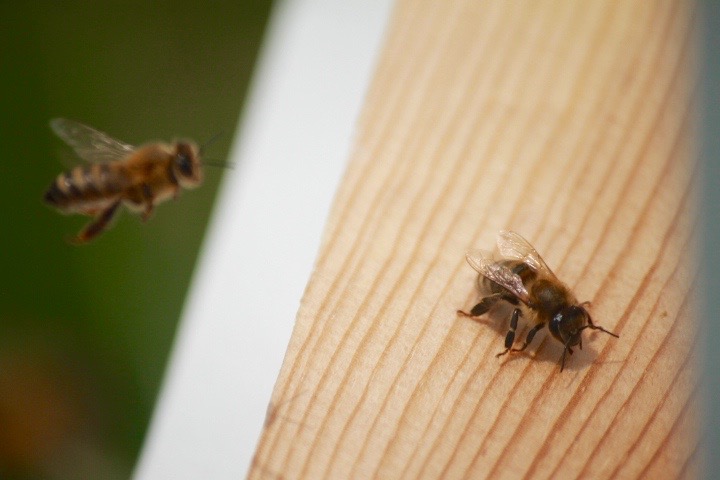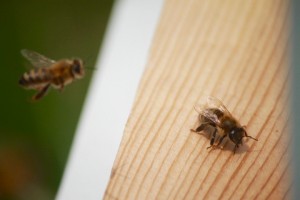On Friday I installed the new package of bees into the second hive box at the farm. They were very active and, to untrained eyes, nothing seemed out of place. Today, Sunday, I returned to remove the empty package box from inside the hive and check to see if the queen had left her traveling queen-cage. On returning to the hive, the attitude of the colony was changed from Friday.
Bees were making their regular orientation flights around the exterior hive body, but they were also incredibly loud and some appeared aggravated (judging on their vibrations and shrill noises). The queen had indeed left the queen cage, which was to be wished for, but something seemed wrong. On the outside of the now-empty package box there was an aggressive ball of bees attached to the outside. Over them, about 60-80 bees crawled over them, some passing by with their day, and others contributing to the moodiness.
Based on past reading and my instinct in the moment, I realized that the queen was inside the bundle. Could this possibly be balling, the colony’s rejection of the queen and their attempt to murder her by means of overheating? My mom was there and as I took to inspecting over different parts of the hives and replacing the space the empty package had taken up with frames, she attempted to dismantle the ball to look for a queen. She found that the queen was definitely inside the ball, and to save us some thinking time, captured her with a queen-catcher to remove her from the aggressive worker bees.
My mom is just as new to beekeeping as I am and we were both overwhelmed with this activity that was present in this new hive. Our instincts agreed that this activity was aggressive, or at least that the colony was aggravated, possibly from a long journey on the bee-truck or from the rainy weather that has been forecasted for Monday.
From this intuition, we concluded that a)the colony had not be righted (meaning they had not accepted their queen and it was causing disorder in the hive) OR b)this box had come with two queens, one within the cage and one that had been roaming freely within the package box.
Either way, we realized that over the next week this hive is going to need some extra attention.

The corner of the hive’s entrance. The white bottom board that shows on the exterior of the hive was covered in bee feces, a common sign of bee stress. Normally, bees are overwhelmingly clean insects and do not defecate this close to the hive. Upon speaking to other beekeepers that bought packages from the same place, their bees were extra-poopy as well.
I spent the next hour creating a sugar water mixture to feed to the hive as a way to calm them. During the transition phase of a new hive, sugar water is often easier for the bees to access than nectar, despite being less affective nutritionally.
When I took the sugar water to the hive feeder, I checked in on the queen in her catcher, who we hung in between two frames like one would originally do with a queen-cage. Some of the workers had crawled inside the catcher with her and the aggressive bundle had reappeared around the plastic. At least now, thanks to the catcher, the queen would have more air than if she was left alone to die inside the balling of bees.
I will have to continue checking on the hive for the next few days and take note on how their behavior changes. This kind of hive-drama is nothing beekeepers haven’t seen before and within the week, the bees will more than likely have found a solution themselves.
This post has no well-defined, concluding ending given issue playing out within the colony. But here are three possible scenarios that I imagine happening given the circumstances and a breakdown of each:
Scenario 1: The Saddest Anarchy Movement You Ever Did See
There’s kind of a problem, but it’ll solve itself in about three days. Right now, the workers are trying to kill their queen. Well, *scoff* not their queen, but a queen. “Her pheromones are all wrong; we could never accept her!” Give it some time, and that queen will become theirs. Once they realize that they have no other options and her scent has spread throughout the entire colony, they will accept her royalty and hive-life will become peaceful. As beekeepers, we will then remove the queen from the catcher will no fear of her untimely demise.
Scenario 2: It’s Fiiiiine!
There is no problem whatsoever. The only issue that is causing upset within the colony is the upcoming rain and the stress from their recent traveling. The “balling” of bees we witnessed was simply the workers protecting the queen to keep her warm from the cooler weather that will come with tomorrow’s rain. It seems that if the workers were genuinely balling the queen, it would have been much more difficult to extract her from the bundle and capture her in the catcher. Videos of balling show the same movements and attitude that we saw in this bundle today, but narrators described trying to remove the queen as a much more trying process. Because of this, we could conclude that the bundle we saw was not balling, but protection from the elements. In this case, if we removed the queen from the catcher, the workers would not kill her and all aggressive activity would die down in a few days.
Scenario 3: Lesbian Queens: “Finally, thank you, Disney!”
Packaged bees come with one queen, except for when they come with two. In this case, there may have been a second queen crawling around with the workers while a second queen was confined to the queen cage. This scenario is a bit more complicated than the other two but no less manageable. If this is the case, we will know in a few days. If brood or eggs appear in the comb, it will be obvious that there are two queens because there would be no way for the queen in the catcher to lay them. In this case, we will remove the queen in the catcher and any of her followers into a nuc box with some frames holding premade comb and honey (if available). This will return peace to the colony that remains with queen #1 and a new colony will be built by queen #2 and her following worker bees.
As I’ve stepped away from the hive this evening, I am beginning to feel that Scenario 2 is the most likely. But only time will tell and it will undoubtedly become very apparent in the next few days as I check for brood and eggs and as I examine the behaviors that the workers exhibit after tomorrow’s rain.



Leave a Reply